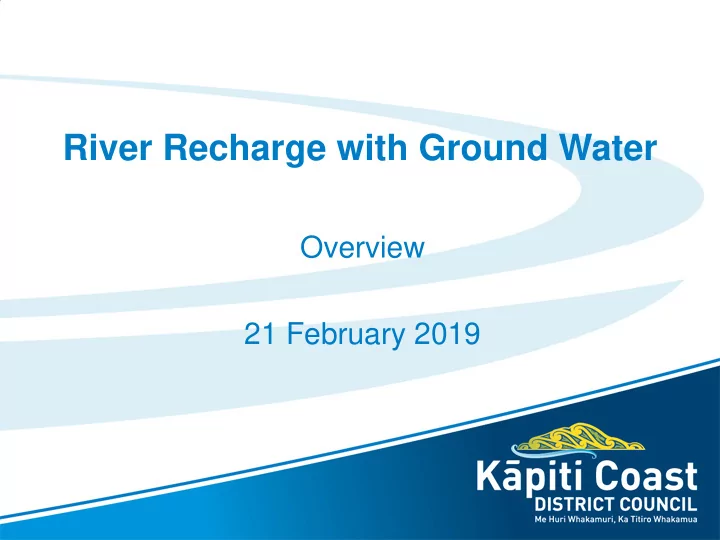

River Recharge with Ground Water Overview 21 February 2019
The search for water 2001 Ōtaki River pipeline declined 2003 Water Matters Strategy Inc water metering 2008 and Peak demand target 490 l/p/p/d 2005 Supplementary groundwater added (hard water) Increasing growth pressures and high water use 2009 Council committed to well-resourced project to deliver 50-year solution 2010 GWRC confirm no ability to assist with additional supply
The water supply solution • 2010 River Recharge with Groundwater confirmed as preferred option – Staged flexible programme – Iwi Support (Water Working Group) – Purchase land for Dam – Demand risk still an issue
River recharge timeline
Consenting Investigations • Extensive investigations to inform and support consenting process • Demand modelling • Surface water yield modelling • Aquifer testing and groundwater modelling Aquatic ecology Wetland ecology Cultural impact assessment
Consent Approval • November 2012: AEE lodged – 23 submissions • June 2013: Hearing before independent commissioners • September 2013: 35 year consent granted – Innovation • Ground water discharge to river so more river water could go to supply • No NZ precedent – Extensive monitoring regime • 3 year baseline monitoring • Adaptive Management – 20% restriction on river recharge during baseline • 78 pages of conditions • 139 individual consent conditions
River recharge in operation River intake to WTP Groundwater discharge into the river Recharge to river Discharge swale
Baseline monitoring • 3 Years of baseline monitoring of – Waikanae River – 7 Small Coastal Streams – 13 Wetlands – 32 Borefield sites • Adaptive management – Annual review process – Iwi & Regional Council – 6 stakeholder groups
136 Automated data parameters • 7 Small Coastal Stream site – Each with in stream DO, Temperature, and water level. Plus piezometer ground water level. – 13 Wetland sites • Each with a piezometer ground water level. Some sites have more than one piezometer. • Borefield sites – 13 Electrical conductivity sensors – 32 Piezometer ground water level sensors across deep and shallow aquifer • River and WTP sites – Water level in river – 2 Raingauges – 8 Production bores data collection including instantaneous pump rates and daily abstraction rates – 3 flow meters through the WTP
1400+ Manual data parameters • 320 Production Bore Water quality sample parameters (monthly) • 520 Wetland condition monitoring parameters across 13 sites, plus aerial photos + photo points • 180 at 5 River Condition monitoring parameters across 5 locations (every 2 weeks or more in summer) • 378 Small Coastal Stream parameters across 7 sites (monthly) • 6 parameters across 2 River flow gauging sites • 7 Small Stream Fish Surveys • 5 Waikanae River Fish Surveys • 2 Upstream Tributary Fish Surveys • Additional Borefield water depth and EC measurements as needed. • Additional monitoring as and when needed should trigger levels activate.
Waikanae River • Water level in river. • Two Rain gauges. • Intake and discharge data. • Blended bore water sampling.. • Manual river monitoring. – 9 water chemistry parameters – Water temperature – Periphyton (algae) – macroinvertebrates • Waikanae River Fish Surveys four times a year. • Two Manual River flow gauging sites • Two Upstream Tributary Fish Surveys.
Small Coastal Streams • 7 SCS Baseline Sites • In stream DO • Temperature • Water level. • GW Piezometer level • Manual data monthly (summer) • Fish surveys • Bug surveys • Cross Sections
Wetlands • 13 Wetland Baseline Sites • Ground water level. – Automated piezometer – Some sites had up to 3 piezos • Annual manual wetland condition monitoring • Aerial photos • Photo points
Borefield 32 Borefield Sites Ground water level. Automated piezometer Deep and shallow aquifer. 13 Electrical conductivity sensors. Additional Borefield water depth and EC measurements as needed. Manual Borefield water depth and EC measurements for calibration. Additional monitoring as and when needed should trigger levels activate. 8 Production bores pump rates daily abstraction rates. Monthly Bore Water quality samples
Borefield water level
Adaptive Management
Completion of 3 year of BLM • Annual adaptive management stakeholder participation and support • 4 Star green rating – Every year of baseline monitoring – Top GWRC compliance ratings • 30+ compliance reports submitted to GWRC • Nov 2017 GWRC confirmed – Completion of baseline monitoring requirements – Removal of the 20% restriction on river recharge.
Key Outcomes • Provides 50 year supply solution • 35 year resource consent • Can be staged as demand increases • Highest GWRC consent compliance rating • Enhanced understanding of Waikanae River, wetlands, small coastal streams and borefield • Maintains minimum flows in the Waikanae River • Significant Iwi and stakeholder engagement • Successful adaptive management • Sustainable use of exiting resources
Recommend
More recommend